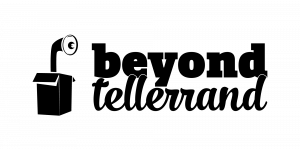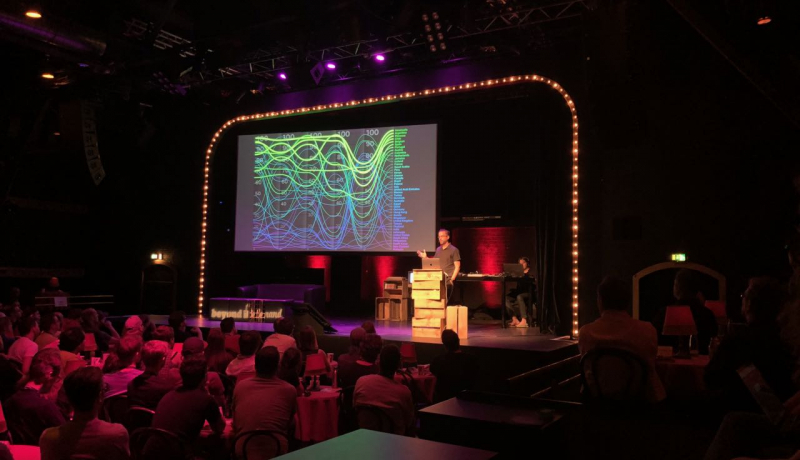
Beyond Tellerrand 2019
I’m sat at the airport in Dusseldorf, Germany, waiting for my Apple struddel to arrive… ooh it just arrived and it looks delicious.
Now I’ve got that out of the way, it’s time for my annual reflection on what an amazing conference the Beyond Tellerrand was for another year.
It’s a funny kind of feeling immediately following the conference. One one hand I’m excited about the ideas I’ve gleaned from the speakers, I’m inspired to take my work in new directions, and I’m in awe of the amazing work that both the speakers and other attendee’s are doing.
On the other hand, it’s also an incredibly low feeling that comes at this point.
For the past three days I’ve been immersed in an ocean of creativity and inspiration in a world where any seems possible, and surrounded by the good friends that I’ve made over the past 5 years attending this event.
Over the next 360 days I’ll occasionally see them pop up on Twitter and Instagram, and I’ll watch and share their contributions to the world, but largely we won’t be in touch again until Beyond Tellerrand roles around again. That is what makes the event so special to me, the fact that I know I’ll see the familiar faces and we can catch up on how our careers are going, how are kids are going a year later and hang out as friends who are part of the Beyond Tellerrand family.
So then, putting to side my low feeling that it is ending let’s turn to all the amazing things of the conference.
Charlie Owen
The conference kicked off with Charlie Owen throwing a massive find and F**k you to the likes of Facebook.
Charlie never holds back in her talks and if she doesn’t like something, you certainly know about it, but it wasn’t that which I took from her talk.
Instead, she quite eloquently set the tone and common thread of the conference when she talked about constraints and how that it was these constraints that allowed us to produce our best work.
I think constraint was one of the biggest challenges that faced designers when responsive design arrived. All of a sudden the 960px or 1024px window was no longer the fixed canvas they had to create on, all of a sudden the designs needed to work at any viewport.
You can read more about Charlie on her site.
Carolyn Stransky
I wasn’t previously aware of Carolyn ahead of this conference and it took until the Accessibility club that was on today for me to get a chance to have a quick chat with Carolyn (who is super nice incidentally).
Carolyn spoke about documentation and how to bring a Human touch into the documentation. Rather than focusing on what your product does or how it does it, explain your product through the documentation by showing users how they might accomplish the tasks that your product is designed for.
It was during Carolyn’s talk that my mind began to wonder about things that would be super helpful as well. Carolyn talked about Slack and I wandered if there was an easy Slack integration that would be able to keep track of my expenses, or another one that might be able to keep track of the work that I’m doing so time sheets are easier at the end of the week.
Both those things have nothing to do with Carolyn’s talk, but I always find it funny the things that pop into your head during moments of inspiration.
The words you use
There were a few examples of terminology you should and shouldn’t use, but these all struck a chord with me
- Don’t use Master/Slave, you should use Primary/Replica to describe the same thing rather than reinforce our poor treatment of humans
- Black List / White List — does it need any clarification about how horrifically racist this is. What is worse is that it had never previously occurred to me. Instead, use Deny/Allow List.
- Just/Simply – don’t make things sound simple because someone using your documentation will be doing so for the first time and it won’t seem like they ‘just’ need to do something ‘simple’.
One of the tools that Carolyn shared was Alex.js which parses your content through a set of rules and provides you feedback about the types of terms you should watch out for. I just copied this article and ran it through the checker and had the following results:
- 1:96-1:100
justmay be insensitive, try not to use it - 11:51-11:54
popmay be insensitive, useparentinstead - 11:258-11:265
specialmay be insensitive, usehas a disability,person with a disability,people with disabilitiesinstead - 11:380-11:384Be careful with
kids, it’s profane in some cases - 18:29-18:32
hermay be insensitive, when referring to a person, usetheir,theirs,theminstead - 18:46-18:49
shemay be insensitive, usethey,itinstead - 18:140-18:143
hermay be insensitive, when referring to a person, usetheir,theirs,theminstead - 20:10-20:13
shemay be insensitive, usethey,itinstead - 20:85-20:88
shemay be insensitive, usethey,itinstead - 25:36-25:39
hermay be insensitive, when referring to a person, usetheir,theirs,theminstead - 32:167-32:171
easymay be insensitive, try not to use it - 34:102-34:105
popmay be insensitive, useparentinstead - 39:15-39:21
Master/Slavemay be insensitive, usePrimary/Replicainstead - 39:22-39:27Don’t use
Slave, it’s profane - 40:5-40:10Reconsider using
Black, it may be profane - 40:18-40:23Reconsider using
White, it may be profane - 40:85-40:91Reconsider using
racist, it may be profane
Other tools that were recommended included
- https://github.com/btford/write-good – similar to Grammarly or Hemmingway App but for your text editor
- Don’t say simply – https://www.youtube.com/watch?v=1vvjiJFsT-Y&t=2367s
- Mark Down Cheat Sheet – https://bit.ly/md-cheatsheet
Check out Carolyn’s website, and take a look at her video below.
Mike Hill
I’ve got Mike down as talk of the conference, which is a pretty tall order considering the calibre that was on show over the two days.
Mike made me realise that really great film makers play on the way in which our brains work and use this to deliver us amazing story lines that keep us coming back to the box office time and time again.
He framed the opportunity to tell stories very early on, and put a great emphasis on the types of stories that we share with the world. The content we create, the stories that we share, has a profound effect on an individual.
For example, you are reading this post and I’m hoping that I can in some way influence you to watch these talks, follow these speakers, and ideally I’ll see you at the event next year. I consider these to be good influences.
On the other hand certain social and news networks and some high up government officials tell other stories to sway your opinions for the worse. They tell stories that effect you to vote in a particular way.
The example that Mike used was the book that influenced Hitler, and as a result of this story caused Hitler to persecute the Jews in the Second World War with millions of deaths as a result.
Mike went on to talk about the Monomyth and take us through the 12 step process of story telling in movies which keep us coming back to the movies time and time again. Movies like Star Wars, the Dark Knight, and Jurrasic Park all contain the key elements of this story telling.
It was truly a remarkable talk, and if you only have time to watch one video on this page this is certainly the one you should start with.
Red
Red’s story started with her leaving Malaysia to study architecture in Australia before finding it difficult to find a job within her profession thanks to the economic downturn at the time.
This unfortunate series of events led her to working in China and reconnecting with her Aunty and Uncle, the latter of which was an artist himself who painted Chinese propaganda posters in the early 20th Century.
Saddened and disillusioned from this work, Red’s uncle threw his paintbrushes away never to paint again, which was then the catalyst for Red herself to put down the brushes and find another way to create.
What followed was a wonderfully creative portrait of a Chinese basketball player using the basketball to literally bounce the painting into existence. This continued with
- a sock art portrait of the Director of Hero, Zhang Yimou
- a chopstick portrait of the legend Jackie Chan
- a coffee cup portrait of an emo Chinese pop singer
Red showed that you don’t need the best canvas and nicest paints/tools in the world to create amazing pieces of work. She also showed to me that you sometimes need to take a little leap of faith and follow your passion because you never really know where that is going to lead you.
David Carson
A legend in his field, David talked about his Career of steering clear of the guidelines and following what he thought was right and not necessarily what best practices in graphic design demanded.
The key thing I loved about David’s work was that he read/listened to the content before he even tried to put something together as a layout. He would wait to see how the piece, whether it was an album or an article, would make him feel and then transform that feeling into his layout.
No two spreads in his magazines were ever the same, and while I disagree in general with his take on readability I did like his theory
If people are interested in reading the article they’ll put up with really long line lengths, small type, and overlapping lines.
The essence of David’s point about the legibility of some of his layouts.
It was wonderful to see a legend’s work and his process.
Rob Draper
I had already seen Rob speak at Reasons to be Creative so I was really looking forward to seeing him again and seeing what an extra year has meant on his journey.
Similarly to Red, Rob is all about creating art with what ever you have at your finger tips. He creates beautiful pieces with used coffee cups, opened envelopers, paper plates, salt packets, and even chopsticks (Rob referenced Red in his talk about the Chopsticks and said it was the hardest thing to work with ever, next time pick squared chopsticks :)
Rob’s talk is incredibly uplifting, although he certainly takes you through the downs as well as the ups. I’ve seen the talk twice now and each time I’ve taken something a little different from it, but both times it has inspired me to keep working hard at what I love to do and Create More.
I especially enjoy the idea that Rob brings through from his early days of Graffiti in that you should
- Do the work
- Get the shot
- Move on
In addition to really enjoying his talk, I was fortunate to run a side project with Rob to develop a set of Coffee Cup Notebooks, you should pick up a set.
David Delgado
Now, if I had to pick what my most idealistic career would be it would have something to do with Space and the Universe, and likely be with SpaceX, ESA, or NASA.
David made his journey over from California and works out of JPL (Jet Propulsion Lab) as one of their designers (think visual designers for publicity rather than engineer designer building rockets).



